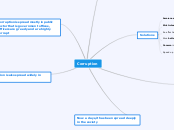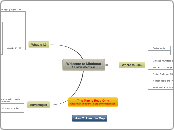Where next?
You can continue to develop this map without the Smart Map wizard by saving it as a normal Mindomo map.
When have a comprehensive description of the problem, you can move towards finding solutions. Consider a brainstorm as a next step, using the Brainstorming Toolbox Smart Map.
You can delete this topic from the saved map.
Welcome
Researching and describing a problem clearly is the foundation for solving it. Solutions based on incomplete research or poor descriptions can often fail to reach the root causes.
This Smart Map helps you to research and describe a problem from a number of different angles. It contains a mix of factual information-gathering tools and lateral thinking techniques, to develop perspectives that can point towards solutions.
You can use this map individually and in collaboration with others. It is vital to get consensus on the actual problem you are facing, otherwise there may be no consensus on the solution. Putting the descriptions together in one place helps you to explain and agree upon the basis for finding and evaluating solutions.
You can delete this topic from the saved map.
Hey, take a look at the comment bubble
6) 601 - Rock, Paper, Scissors (v3)
GIST(General Idea of Some Thing): Write a console-based program that will allow a user to play Rock-Paper-Scissors against the computer.
Abstract: The console-based program will (describe what happens, paint a word-picture)
Be the problem
Be the problem is a popular technique for understanding problems. It means developing a character for the problem and describing its nature as if it were a person.
Insight
Analogies
Can you find analogies for this problem?
The underlying characteristics of a problem can sometimes be clearer when it is taken out of context.
What is it like?
Six serving men
"Six Serving Men" is based on Rudyard Kipling's poem, which begins:
''I keep six honest serving men
(They taught me all I knew);
Their names are What and Why and When
And How and Where and Who.''
We can profile a problem and perhaps discover more about it by asking structured questions.
Who?
Who not?
Where?
Where not?
How?
How not?
When?
When not?
Why?
Why not?
What?
What not?
Impact analysis
Impact analysis looks at who is affected by the problem - what the consequences are, rather than the causes.
Person
Impact
Root cause analysis
For analytical problems, root cause analysis can help to unravel indirect causes of problems, leading to more effective solutions. One way to do this is to keep asking "Why?" down to five levels, to understand the reasons behind the reasons.
Cause
Solution criteria
How will you know when you have solved the problem?
* What will a successful solution look like?
* How will you filter and assess potential solutions?
* How will you verify that the issue has been solved?
You might want to return to the solution criteria several times as you develop the definition of the problem.
internally, both the computer choice and
user choice will use the same data type
This doesn't mean that the user has to enter 1, 2 or 3, only that the program is going to represent the user's choice as an integer with a value of 1, 2 or 3
validate user selection
using a function
user may enter either r, p or s, or 1, 2 or 3 to choose rock, paper or scissors
internally, use ROCK, PAPER or SCISSORS to represent the user's choice
NOTE: this is where you will use a while loop
use constants for choices and outcomes
const int ROCK = 0; // 0 - rock
const int PAPER = 1; // 1 - paper
const int SCISSORS = 2; // 2 - scissors
// possible outcomes/results
const int WIN = 1;
const int LOSE = -1;
const int TIE = 0;
computer will generate a
random number 0, 1, or 2/
ROCK, PAPER or SCISSORS
if/else if/else, switch or
while (looping) logic only
user will indicate:
Program will terminate when player selects exit
Also, provide option to stop the "madness"
Note to self: next version will display a menu where the user can select an option to display help, another option to play a single game or another option to play a best of
Exit
Display help
Play best of
Play a single game
display help if user doesn't
know how to play RPS
write functions
Console-based
program
program will continue until user selects exit from the menu
game will continue, using a while loop, until there is a winner
Input:
Get valid input from user
Processing:
Get computer's choice and determine the winner (Nothing is displayed until after all processing has been completed.)
Output:
The computer's choice will be displayed after the outcome is determined.
The outcome of the turn will display after the computer's choice has been displayed.
What assumptions are you making?
In identifying the problem and the probability of a solution, what assumptions are you making?
Assumptions can sometimes be hard to see or accept. For example, if the "problem" is that sales
of a certain product are too low, you may naturally aim to increase sales. You are ''assuming''
that the market demand for this product will continue. But if the demand disappeared overnight in
a storm of negative publicity, then the original problem and solution also change. So the problem
and logical solution are partly based on an assumption.
What don't you know?
What other information might help, but is not available today?
* How would it help?
* How could you obtain it?
* Can you work without it?
* What are the risks or consequences of not knowing?
* Who else might have further information and insight?
Subtopic
randomize computer choice
add a random method?
Random rnd = new Random();
int computerChoice = rnd.Next(1, 4); // creates a number between 1) rock and 3) scissors
making change
with menu
What do you know?
Factual data about the problem
Use case(s)
Narrative of the interaction between the program and the user.
As you develop the narrative, be careful with the nouns and verbs
that you use.
Verbs represent action-function
Nouns represent the things and are converted to variables
Primary
1) Welcome and menu
a) Play a single game
b) Play best of
c) Help
d) Exit
2) Validated input from the user/player
3) Process the menu input, one of the following
a) Play a single game
b) Play best of
1. Prompt user for "best of"
2. Play best of
c) Display help
d) Exit program
* Repeat the above until user selects exit
Playing a game of RPS
1) Get user's valid choice
2) Computer generates its choice
3) Determine winner
4) Display Computer's choice
5) Display outcome
5) THE END ...
4) Output results
2) Display win, lose or draw
1) Display computer's choice
3) Process: the input
2) Indentify winner
1) Computer generates its choice
2) Input: choice from the user/player
description:
rock-1, paper-2, scissors-3
Please enter one of these number values.
1) rock
2) paper
3) scissors
This should be part of a function
2) "Read" user/player input
1) Prompt user for input
1) Welcome ...
2) Display instructions
1) Display title of program
nouns
unknouns
Output:
Process:
game result
computer's choice
Input:
user's choice
knouns
knouns as data translate to ?________? in code
rules
paper beats rock
scissors beats paper
rock beats scissors
game results
draw
lose
win
choices
3) scissors
2) paper
1) rock
Problem type
What tools or patterns apply?
What is the best way to visualize or represent the inputs and outputs for the program?
Expression or series of expressions(simple algorithm)
Timeline?
Collection?
Think about the different types of math word problems you "know" how to solve.









